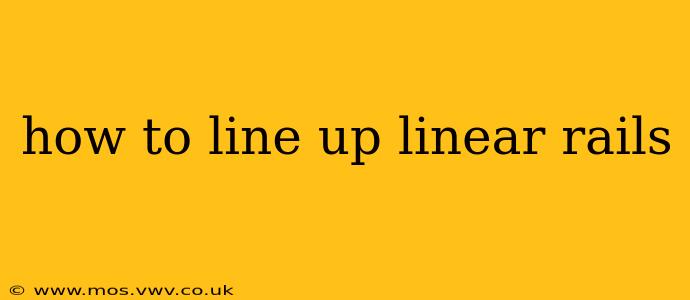How to Line Up Linear Rails: Achieving Precision and Smooth Operation
Linear rails, crucial components in various machinery and precision applications, require meticulous alignment for optimal performance. Improper alignment can lead to premature wear, increased friction, binding, and ultimately, system failure. This guide details how to achieve accurate linear rail alignment, encompassing different scenarios and providing troubleshooting tips.
What are Linear Rails and Why is Alignment Important?
Linear rails, also known as linear guides or linear bearings, provide smooth, low-friction linear motion. They typically consist of a rail and a carriage that moves along it. Precise alignment ensures that the carriage moves smoothly and consistently along the rail's length, preventing premature wear and tear on the components. Misalignment creates uneven loading, causing increased friction, noise, and potential damage.
Preparing for Linear Rail Alignment: Tools and Considerations
Before beginning the alignment process, gather the necessary tools:
- Precision measuring tools: Dial indicators, calipers, and a straight edge are essential for accurate measurements.
- Shims: These are used to adjust the rail's position for fine-tuning.
- Level: A high-quality level helps ensure the rail is perfectly horizontal or vertical, depending on the application.
- Appropriate fasteners: Use fasteners suitable for the material of the rail and mounting surface.
- Torque wrench: This ensures that fasteners are tightened to the manufacturer's specifications, preventing damage to the rails or mounting surfaces.
How to Align Linear Rails: A Step-by-Step Guide
The alignment process varies depending on the type of linear rail and mounting configuration. However, the general principles remain the same:
-
Clean the Mounting Surface: Ensure the mounting surface is clean, free from debris, and properly prepared for mounting the rails. Any imperfections can affect alignment.
-
Mount the Rails: Secure the rails to the mounting surface, following the manufacturer’s instructions. Generally, you'll want to use mounting screws that are appropriately sized and tightened according to the manufacturer's torque specifications. Avoid over-tightening, which can warp the rails.
-
Initial Alignment (Leveling): Use a level to ensure the rails are perfectly horizontal or vertical, depending on the application's orientation. This establishes a baseline for further adjustments. Adjust the mounting hardware as needed to achieve a level surface.
-
Precise Alignment (Using a Dial Indicator): This step aims for precise parallel alignment of the rails. Mount a dial indicator to a stable surface, and bring the indicator's contact point into contact with the carriage. Move the carriage along the entire length of the rail, noting any variations in the dial indicator reading. Adjust the rail mounting using shims or other methods to minimize any deviation.
-
Parallelism Check: It's crucial to check for parallelism between the rails if you have multiple rails. This ensures that the carriage moves smoothly and consistently across all rails. Use the dial indicator to measure the distance between the carriage and the rails at various points along their length. Adjust as necessary to maintain consistent parallelism.
-
Tighten Fasteners: Once the alignment is satisfactory, tighten all fasteners according to the manufacturer's specifications, ensuring a secure and stable mounting.
-
Final Check: After tightening, perform a final check using the dial indicator to verify the alignment hasn't been compromised.
Troubleshooting Common Linear Rail Alignment Issues:
- Binding: If the carriage binds, it's likely due to misalignment or debris. Check for alignment errors, and clean the rails and carriage thoroughly.
- Uneven Movement: This usually indicates misalignment. Carefully check for parallelism and levelness using a dial indicator and a level.
- Noise: Excessive noise often points to misalignment, increased friction, or debris. Check for misalignment and clean the rails and carriage.
Different Types of Linear Rails and Alignment Considerations:
Different types of linear rails, such as linear ball bushings, roller guides, and linear bearings, might require slightly different alignment procedures. Always refer to the manufacturer's instructions for specific alignment recommendations.
By carefully following these steps and paying attention to detail, you can ensure the precise alignment of your linear rails, leading to smooth operation, extended lifespan, and improved performance of your machinery. Remember that precision is key; take your time and use the appropriate tools to achieve optimal results.
